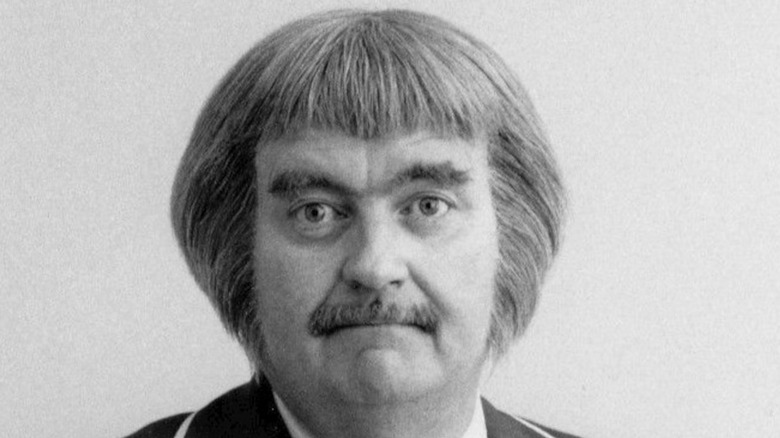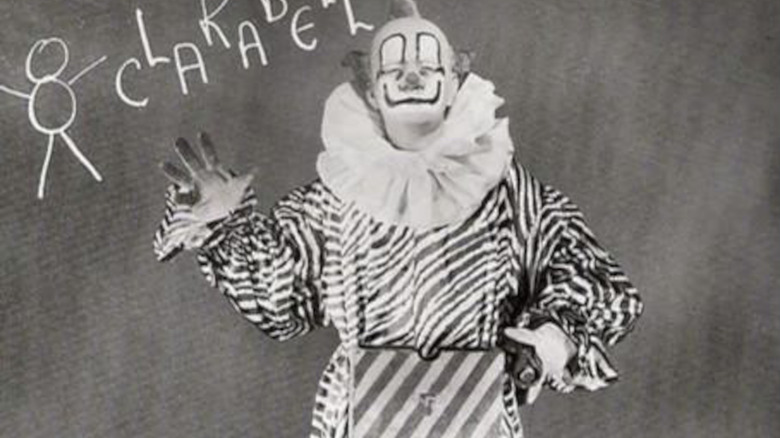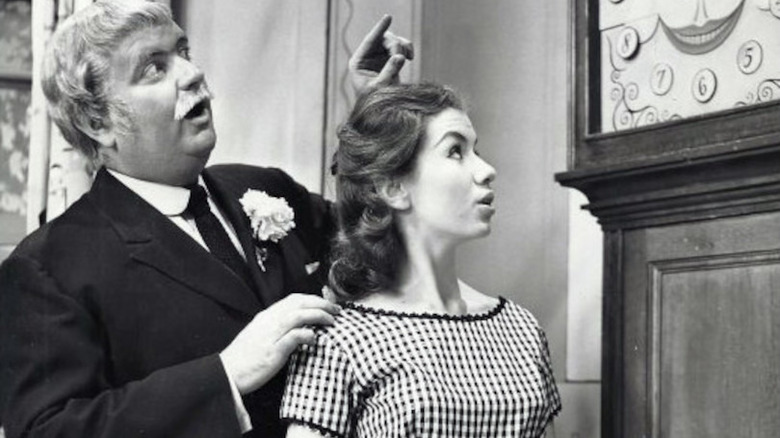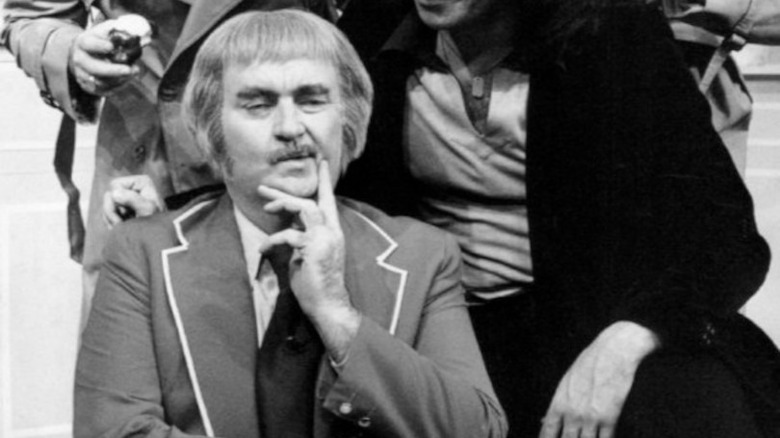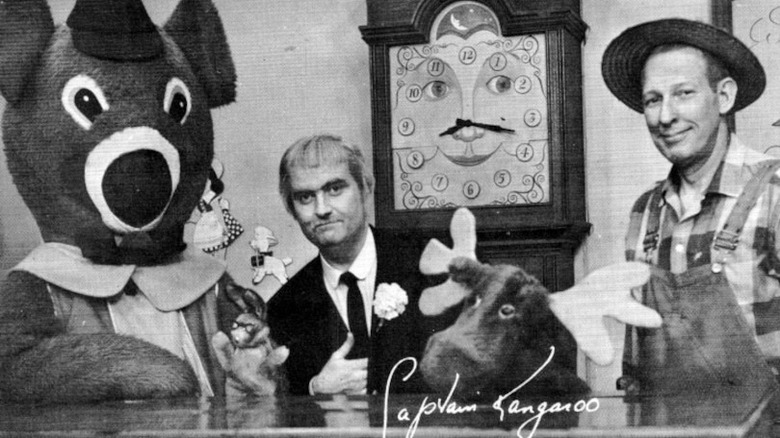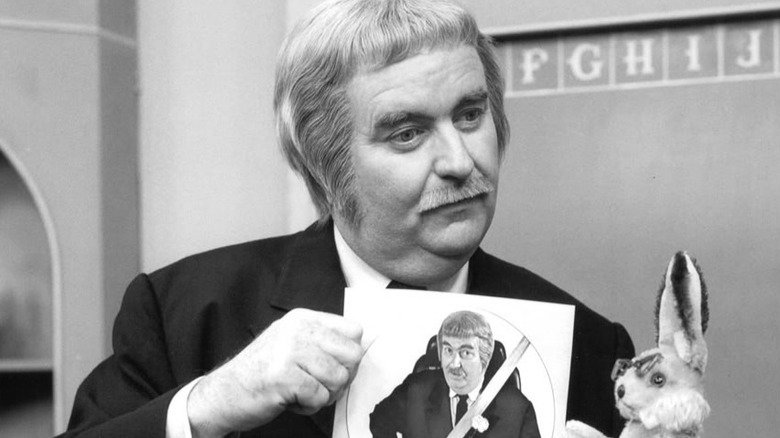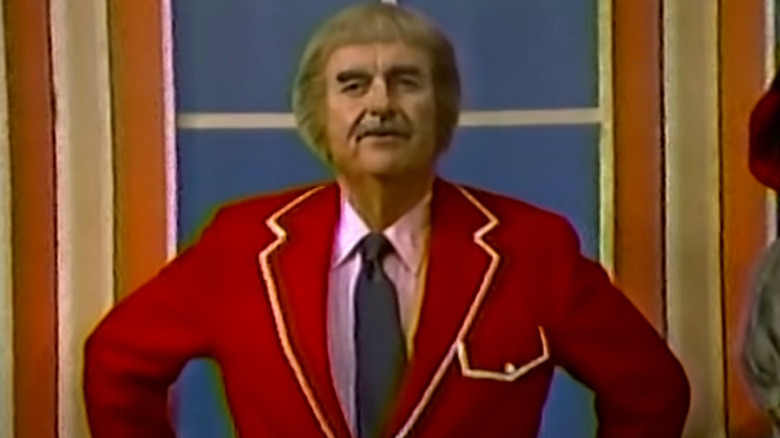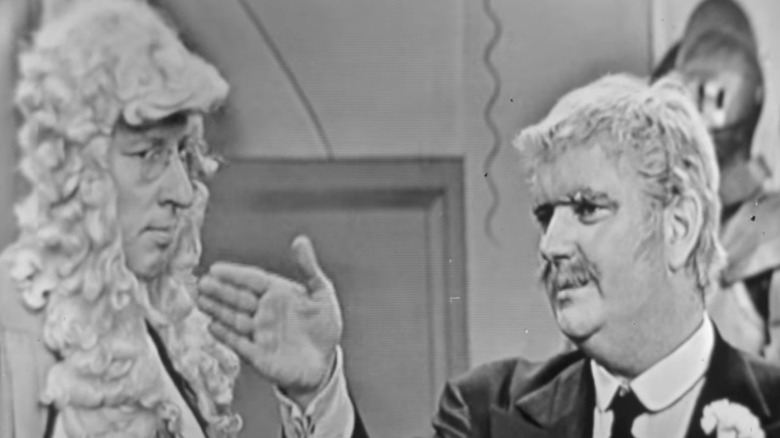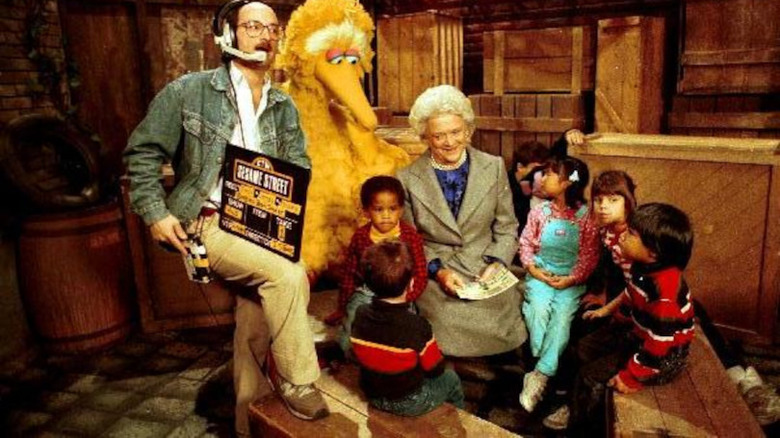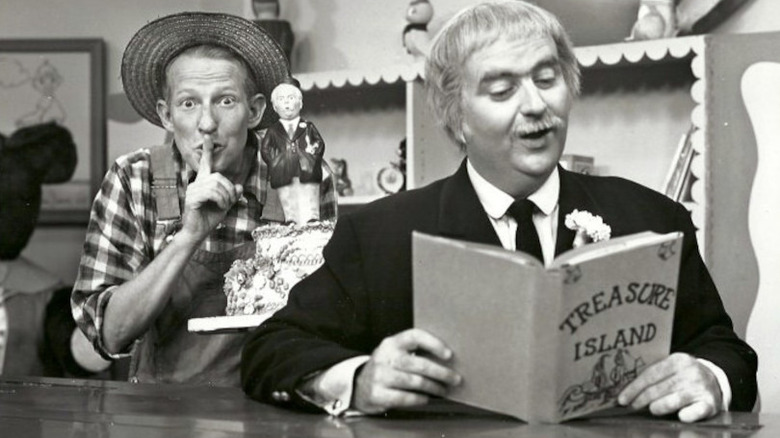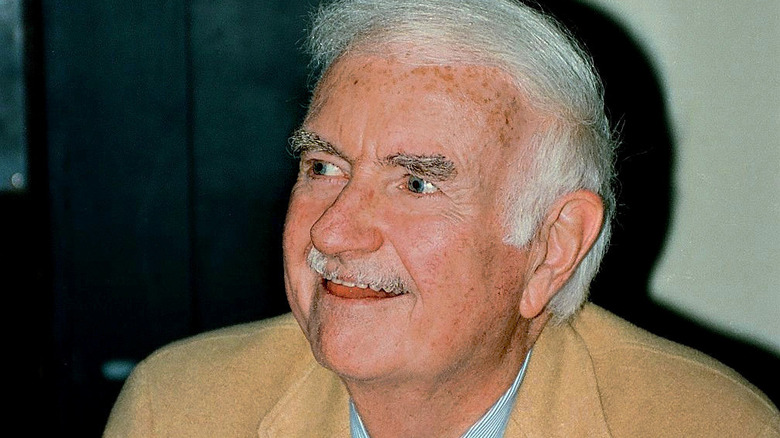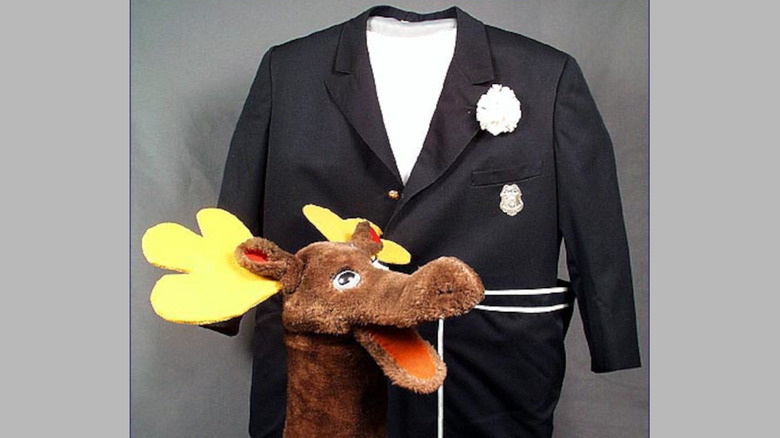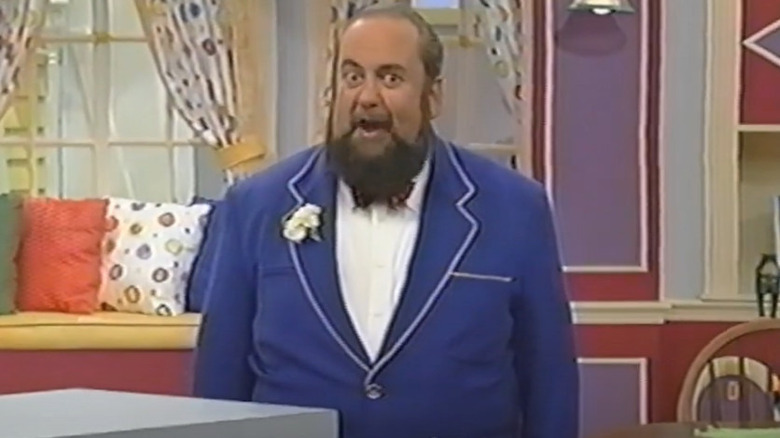Throwback Facts About Captain Kangaroo
For people of a certain age, the name Captain Kangaroo recalls fond memories from their childhood. Debuting in 1955, "Captain Kangaroo" starred Bob Keeshan as the titular character, a genial, soft-spoken man with white hair and a large, bristly mustache. Dressed in a uniform jacket with enormous pockets (which the encyclopedia Britannica reports inspired the name, as they resembled a kangaroo's pouch), the Captain disguised educational material inside fun, whimsical entertainment.
The show had a large cast of regular characters, including soft-spoken farmer Mr. Green Jeans, Dancing Bear, and others. Promoting reading and teaching simple lessons about being a good student and a dutiful child, the show ran for 29 years, finally leaving the airwaves in 1984.
Despite being off the air for decades, "Captain Kangaroo" remains an enduring part of our shared pop culture. Unsurprisingly, a show with that kind of staying power left behind a deep mythology and history that stretches back to the earliest days of television itself. Here are some throwback facts about "Captain Kangaroo."
Bob Keeshan was a veteran
Not only did Bob Keeshan serve in the United States Marines towards the end of World War II — although the war ended before he saw combat, per the South Florida Sun-Sentinel – he was also a veteran of children's television by the time "Captain Kangaroo" launched. By the show's debut in 1955, Keeshan had already spent several years performing as various clowns on TV.
It was on the "Howdy Doody Show" that Keeshan accidentally found himself on screen for the first time, as reported by The Washington Post. A cue-card boy for the show, he wandered in front of the cameras and was promptly put in a clown costume — the only outfit immediately to hand — by the producer. He took to it well, developing himself into the character Clarabell by 1948, per Britannica. Famous Clowns reports that Keeshan was summarily fired in 1950 because he couldn't play a musical instrument. The show's audience of kids didn't like the replacement Clarabell, however, and Keeshan was quickly rehired into the role. The Los Angeles Times reports he was fired a second time in 1952 — right around Christmas.
Keeshan went on to play Corny the Clown on a show called "Time for Fun" in 1953. And later that year, Keeshan was cast in another children's program, "Tinker the Toymaker." So when "Captain Kangaroo" hit TV screens on October 3, 1955, Keeshan was an old hand at children's television.
The show had grandpa energy
If you have memories of "Captain Kangaroo" on television, you know that the Captain always seemed like an old man, particularly due to his white hair. As noted by The National Herald, this image of the Captain as a grandfather was reinforced by his demeanor, which was always patient and gentle. The fact that Captain Kangaroo always had grandpa energy is remarkable when you realize that Bob Keeshan was just 28 years old when the show debuted in 1955, per The Washington Post.
As Keeshan himself noted in his autobiography "Growing Up Happy," that grandpa energy was always part of the concept. His early experiences on children's television shows like "Howdy Doody" had convinced him this warm, pleasant persona would be the best approach to bonding with juvenile audiences. Having observed his own father as a grandparent and how quickly he had built a relationship with Keeshan's young son, Keeshan decided to base his Captain Kangaroo character on that relationship, to try to be a fun, affectionate grandfather to all the kids tuning in.
The result was a TV show that was essentially a safe space for all the kids watching. Keeshan never raised his voice or became angry, and the lessons "Captain Kangaroo" taught were focused on building up self-esteem, tolerance, sharing, and other positive attributes.
The theme song was stock music
The opening sequence of "Captain Kangaroo" was one of the most iconic parts of the show. As noted by The Washington Post, many episodes began with various celebrities and other people saying, "Good morning, Captain!" followed by the Captain himself. Depending on your age, you might remember the theme music differently — The Saturday Evening Post notes that the original theme song was "Puffin Billy" by Edward White.
As noted by author Joseph Lanza in the book "Elevator Music," the song wasn't created for "Captain Kangaroo." At the time, television networks didn't have in-house composers, so they often used "collections" — the stock music of its age. "Puffin' Billy" was part of a collection offered by a company called the Chappell Recorded Music Library, and it was used for other television projects before "Captain Kangaroo," including as the theme for a British show called "Children's Favourites." The song would play as the Captain goofed around, stopping when he hung his keys on the key ring just inside the door — but if the keys slipped off, the song would start up again, per The Washington Post.
Last.fm notes that the tune was updated in 1974, by composer Robert L. Brush, and as the show neared its end, a third theme song was composed in the 1980s, called "Here Comes Captain Kangaroo."
It was broadcast in black and white until 1967
It might be mind-blowing to people today, but when television first became part of our lives, the shows were broadcast in black and white. As described by the Los Angeles Times, even though the technology to broadcast in color existed as far back as the early 1950s, it wasn't until the mid-1960s that television networks in the United States began switching over to full-color broadcasts. In fact, manufacturers were still making and selling black-and-white television sets as late as the 1990s.
While many people's memories of "Captain Kangaroo" may be in color, the show was actually broadcast in black and white for the first 14 years of its existence. As noted by The Austin Chronicle, the show was retooled slightly in 1969 to give it a modern look and feel, which included switching from outdated black-and-white broadcasts to color. A couple of years later, the Captain's original blue coat was switched to his more iconic red coat, according to The Saturday Evening Post.
As noted by Time, "Captain Kangaroo" was a show that evolved, meaning that different generations of kids remember a slightly different show. The change from black-and-white broadcasts to color marked a stark dividing line between "Captain Kangaroo"'s first incarnation and its later life — and was a reminder that as fast as technology seems to move, it always takes longer for innovations (like color TV) to become the norm than we realize.
Captain Kangaroo refused to air commercials for toy weapons
As noted by Time, Bob Keeshan always intended his show "Captain Kangaroo" to be a safe space, free from the violence and noise that defined so much programming on television. In fact, The Washington Post reports that Keeshan actually testified before Congress about the danger he perceived in violent TV programming, noting that watching violence on TV as children can have a harmful effect on their development.
Keeshan did more than talk about his commitment to educational programming and to fighting violence on TV. As noted by author David Kamp in the book "Sunny Days," Keeshan refused to allow commercials for violent toys during the broadcast. In fact, in the early 1960s, Keeshan came under severe pressure from CBS to run a commercial for a toy called Johnny Seven O.M.A., which stood for "one-man army." This was a realistic toy that was several weapons in one — a gun, a grenade launcher, and a rocket launcher.
As author Michael Davis reports in his book "Street Gang," CBS informed Keeshan that he was contractually obligated to air the commercials, and if he refused, they would cancel the show entirely. Not only did Keeshan hold his ground, he won: The network not only agreed to not air the commercials during "Captain Kangaroo," it also agreed that shows would be given the option to sign off on advertisements in the future.
The show was in Schwinn's pockets
While Bob Keeshan was adamantly against advertising violent toys on "Captain Kangaroo," as related in "Sunny Days," he wasn't generally against using the show's influence to sell things to children. In fact, "Captain Kangaroo" was a key part of bike maker Schwinn's marketing campaigns in the 1950s and 1960s — to an almost disturbing extent.
As noted by author Lou Dzierzak in the book "Schwinn," Schwinn bikes began appearing on "Captain Kangaroo" in 1958 — not just as advertisements, but literally on the show. Mr. Green Jeans would bring a different model of Schwinn bike onto the set, and Captain Kangaroo would talk about how great the bike was. Schwinn was soon the show's exclusive sponsor, and there's little doubt that the brand's association with "Captain Kangaroo" made it a household name, considering up to eight million children were watching each episode.
In fact, in an article published by the Conference on Historical Analysis and Research in Marketing, Ross D. Petty notes that Schwinn touted its association with "Captain Kangaroo" in its communications with dealers, emphasizing its market reach. When the Federal Trade Commission changed its guidelines around advertising on children's shows in 1971, "Captain Kangaroo" solved the problem by creating a new character — Mr. Schwinn Dealer — in an effort to separate the sales pitch from the beloved characters of the Captain and Mr. Green Jeans.
Keeshan had a backup show
When most people who remember Bob Keeshan think of him, they conjure the image of Captain Kangaroo — few performers are as tightly associated with a single character. But as noted by Nostalgia Central, if you were a kid watching children's television in the 1960s, you might remember that Keeshan hosted a second show: "Mister Mayor."
According to author Wesley Hyatt in his book "Short-Lived Television Series, 1948-1978: Thirty Years of More Than 1,000 Flops," Keeshan conceived of "Mister Mayor" because he was worried he might lose his gig playing Captain Kangaroo. Keeshan was involved in a dispute with his agent, Mitchell Hamilburg, over the rights to the Captain Kangaroo character, and Keeshan worried he might lose and be pushed out. He launched "Mister Mayor" on Saturday Mornings in 1964, so he'd still have a job if things went poorly.
The show had the same gentle tone, with Keeshan portraying a wise, kindly mayor of a fantastical town populated by oddballs and puppets. Behind the scenes, things were less calm: Author Michael Davis writes in "Street Gang: The Complete History of Sesame Street" that Keeshan brought over the writing team from "Captain Kangaroo" to work on "Mister Mayor." However, he didn't offer them any more compensation — despite asking them to work on two shows at once — which sparked a bitter confrontation that ended with the writers walking off the show. In the end, though, it didn't matter: Keeshan and Hamilburg settled their legal differences (via Broadcasting), and he gave up on "Mister Mayor" after just one year.
Many of the show's writers left to work for Sesame Street
"Captain Kangaroo" was a trailblazing show. As noted by author Michael Davis in his book "Street Gang: The Complete History of Sesame Street," it was really the first time network television had created a show specifically to entertain and educate young children, and its success provided a template for most future children's television.
In fact, there's a direct connection between "Captain Kangaroo" and a later iconic children's program — the legendary "Sesame Street." The Washington Post reports that one persistent criticism of "Captain Kangaroo" in its early years was Bob Keeshan's refusal to engage with darker, more complex subjects. As it happens, many of the writers who worked on "Captain Kangaroo" from its debut in 1956 left the show to work on "Sesame Street," which was not only a more dynamic show, but also one intended to bring a bit more reality into children's programming. According to The New York Public Library, Jon Stone was "Captain Kangaroo's" writer, producer, and director for years. He also wrote the pilot script for "Sesame Street," and was the head writer and principal director until 1996.
It wasn't all altruism on the writers' part, though. Davis also notes that many of the "Captain Kangaroo" writers were unhappy working for Keeshan: When he forced them to work on a second show, they became angry and eventually left, with several being recruited to join "Sesame Street" in the aftermath.
Off-camera Keeshan could get weird
"Captain Kangaroo" was a children's program that epitomized pure, gentle entertainment for children, hosted by a gentle, grandfatherly man. And the man who portrayed the Captain, Bob Keeshan, was a staunch opponent of violence in children's programs and a lifetime advocate for children, per The Washington Post.
But behind the scenes, it could be a different story. According to the show's one-time stage manager, Daniel Morgan, in his memoirs "Last Stage Manager Standing," Keeshan could be temperamental and difficult to work with. He would also indulge in some adult pranks that were absolutely inappropriate for a beloved children's program. Morgan writes that while Keeshan stood behind a door, waiting for costar Hugh Brannum (who played Mr. Green Jeans) to finish his introduction at the beginning of the show, he would sometimes pull out his, er, "weenie" and wave it at Brannum. Then, later, when Keeshan was doing his final voiceover, Brannum would get revenge by urinating on his leg.
Morgan admits that Keeshan wasn't all bad — in fact, he could be extremely generous, often giving everyone on the "Captain Kangaroo" staff lavish holiday gifts. And, of course, none of the kids were aware of the adult pranks going on behind the scenes.
Keeshan battled CBS for years
While "Captain Kangaroo" was a calm, gentle presence in millions of children's lives on the screen, behind the scenes, things could get tense. Bob Keeshan, the creator and star, battled with the TV network that aired the show, CBS, for years. According to the show's stage manager Daniel Morgan in his book "Last Stage Manager Standing," a lot of the conflict stemmed from what Keeshan perceived as a cheap attitude towards the show.
Still, "Captain Kangaroo" remained a mainstay of morning television for decades — but as reported by CBS News, by the early 1980s, the television landscape was shifting. Morning news programs were becoming dominant, and CBS needed to make room for more of them. That meant making changes to "Captain Kangaroo" over Keeshan's protests. First, the show was cut from an hour to a half hour, and Morgan notes that the show was also moved to a much smaller studio. Then, The Washington Post reports that it was moved to a much earlier time slot, often airing at 6 a.m., long before most of its core audience was awake. And finally, the show was shifted from the weekdays to the weekends, reducing its presence dramatically.
In 1984, when Keeshan's contract with CBS expired, he stepped down from the show. A few years later, PBS began airing the show as re-runs, but Keeshan had lost his war with television.
Bob Keeshan didn't own the rights
Bob Keeshan stopped appearing as Captain Kangaroo after the show was canceled in 1984, and stopped using the name. This wasn't out of bitterness or pique; even though he created the show, Keeshan didn't actually own the rights to the name or the program itself.
As noted by author Wesley Hyatt in his book "Short-Lived Television Series, 1948-1978: Thirty Years of More Than 1,000 Flops," in 1964, Keeshan and his agent Mitchel Hamilburg were involved in a dispute over the rights to the show, prompting Keeshan to launch "Mister Mayor" as a backup in case he lost the right to portray the Captain. According to "Broadcasting," Keeshan and Hamilburg settled the lawsuit in 1965. But just a few years later, in 1969, The New York Times reports that Keeshan sold the rights to the character to his talent agency, International Creative Management (ICM). As noted by Yahoo! Finance, the founder of ICM, Marvin Josephson, had counted Keeshan as one of his first clients in the 1950s, and built a business empire with "Captain Kangaroo" as a foundation.
The reason Keeshan sold off the rights to his claim to fame was financial: He had three children to support, and hosting a beloved children's program wasn't making him rich. As a result of this decision, Keeshan was not able to use the name or appearance of the character after his contract expired in 1984, and never had any say in whether Captain Kangaroo returned to television.
People keep trying to bring the Captain back
According to The Wall Street Journal, the last time the original "Captain Kangaroo" aired on television was in 1993. Despite its cancellation, people have been trying to find a way to bring the Captain back ever since.
In 1997, someone succeeded — briefly. As reported by Deseret News, in 1997, "The All New Captain Kangaroo" premiered on television, starring John McDonough in the title role. The Chicago Tribune reported that Bob Keeshan — not involved because he'd sold the rights to the show long before — was initially asked to take part, acting as a consultant and making occasional guest appearances. But Keeshan demanded artistic control over the program he'd created so long ago, and declined the offer when he was refused. As noted by CBS News, the new version wasn't a success — it was canceled after just one season.
According to the Asbury Park Press, by 2016, a professional clown named Pat Cashin had bought the rights to "Captain Kangaroo" and intended to revive the show again, but died before he could get it off the ground. And as noted by The Hollywood Reporter, as recently as 2018, actor Mark Wahlberg was trying to revive it again, envisioning a modern version of the Captain as a scientist who taught kids about cool science and technology topics.
